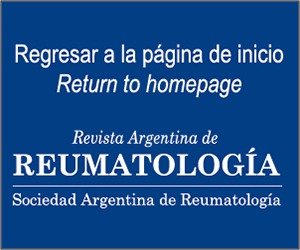Validación del índice Duruöz en una población argentina con esclerodermia
Resumen
Objetivo: El objetivo de nuestro estudio fue adaptar y validar el Indice Duruöz (ID) en una población argentina con esclerodermia.Métodos: Para la validación, reumatólogos tradujeron al español la versión original en francés. Para evaluar la validez constructiva se utilizó la escala global visual análoga del paciente (EVA), EVA para cada una de las preguntas de la misma actividad, el cuestionario de evaluación de salud (HAQ) y el Score modificado de Rodnan para evaluar la piel.Resultados: Se incluyeron 45 pacientes con diagnóstico de esclerodermia. La correlación entre la puntuación total de ID y el EVA global del paciente fue de 0,58, con el HAQ fue 0,63 y con el Rodnan fue 0,08. El coeficiente de correlación entre el EVA y cada grupo de preguntas para la misma actividad en el ID, indicó buena correlación para las preguntas que se refieren a las actividades de cocina, así como para vestirse, de higiene, y para las preguntas de oficina. Se encontró excelente nivel de correlación con los ítems relacionados con las actividades de motricidad fina. La reproducibilidad fue de 0,88 y la confiabilidad de 0,98.Citas
II. Wigley FM. Systemic sclerosis and related syndromes: clinical features. In: Klippel JH, Crofford LJ, Stone JH, Weyand CM, editors. Primer on the rheumatic diseases. 12th ed. Atlanta (GA): Arthritis Foundation; 2001. p. 357–64.
III. Entin MA, Wilkinson RD. Scleroderma hand: a reappraisal. Orthop Clin North Am 1973; 4:1031–8.
IV. Palmer DG, Hale GM, Grennan DM, Pollock M. Bowed fingers: a helpful sign in the early diagnosis of systemic sclerosis. J Rheumatol 1981; 8:266–72.
V. Poole JL. Grasp pattern variations seen in the scleroderma hand. Am. J. Occup Ther 1994; 48:46–54.
VI. Poole JL, Steen VD. The use of the Health Assessment Questionnaire (HAQ) to determine physical disability in systemic sclerosis. Arthritis Care Res 1991; 4:27–31.
VII. Poole JL, Watzlaf VJM, D’Amico F. Hand risk factors for the development of disability in scleroderma [abstract].Arthritis Care Res 1996;9:S20.
VIII. Sandqvist G, Eklund M. Hand Mobility in Scleroderma (HAMIS) test: the reliability of a novel hand function test. Arthritis Care Res 2000;13:369–74.
IX. Sandqvist G, Eklund M. Validity of HAMIS: a test of hand mobility in scleroderma. Arthritis Care Res 2000; 13:382–7.
X. Backman C, Mackie H, Harris J. Arthritis Hand Function Test: development of a standard assessment tool. Occup Ther J Res 1991; 11:245–56.
XI. Backman C, Mackie H. Arthritis Hand Function Test manual. Vancouver: University of British Columbia; 1997.
XII. Poole JL, Gallegos M, O’Linc S. Reliability and validity of the Arthritis Hand Function Test in adults with systemic sclerosis (scleroderma). Arthritis Care Res 2000; 13:69–73.
XIII. Guccione AA, Jette AM. Multidimensional assessment of functional limitations in patients with arthritis. Arthritis Care Res 1990; 3:44–52.
XIV. Duruoz MT, Poiraudeau S, Fermanian J, Menkes C, Amor B, Dougados M, et al. Development and validation of a rheumatoid Duruoz’s Hand Index that assesses functional handicap. J Rheumatol 1996; 23:1167–72.
XV. Poiraudeau S, Chevalier X, Conrozier T, Flippo RM, Liote F, Noel E, et al. Reliability, validity, and sensitivity to change of the Cochin Duruoz’s Hand Index in hand osteoarthritis. Osteoarthritis Cartilage 2001; 9:570–7.
XVI. Brower LM, Poole JL. Reliability and Validity of the Duruöz Hand Index in Persons with Systemic Sclerosis (Scleroderma). Arthritis Rheum. 2004, 51 (5): 805-9.
XVII. The American Rheumatism Association. Preliminary criteria for classification of systemic sclerosis (scleroderma). Arthritis Rheum 1980; 23: 581-590.
XVIII. Clements PJ, Furst DE, Seibold JR, Lachenbruch PA. Controlled trial design issues in Systemic Sclerosis, 1995, p: 515-33.
Derechos de autor 2015 A nombre de los autores. Derechos de reproducción: Sociedad Argentina de Reumatología

Esta obra está bajo licencia internacional Creative Commons Reconocimiento-NoComercial-SinObrasDerivadas 4.0.






